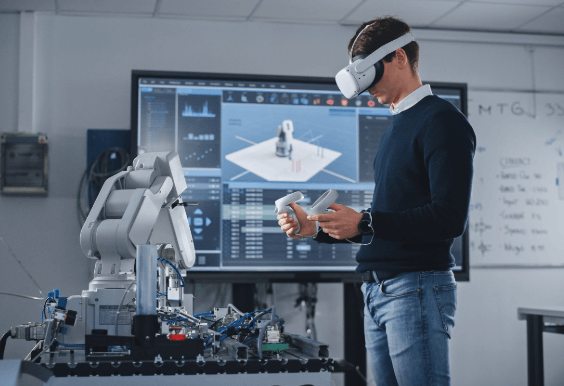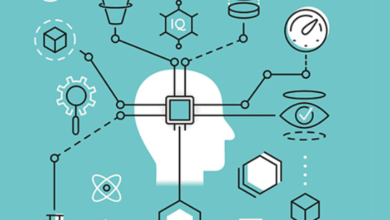Virtual Reality in Education and Training

Virtual reality (VR) is revolutionizing education and training by creating immersive, interactive experiences that enhance learning and skill development. Unlike traditional teaching methods, which often rely on lectures or written materials, VR enables users to engage with realistic, simulated environments. This technology has proven to be a game-changer across various fields, including healthcare, aviation, manufacturing, and education, offering unparalleled opportunities to improve knowledge retention, safety, and accessibility.
Understanding Virtual Reality in Education and Training
Virtual reality is a computer-generated simulation of a three-dimensional environment that users can interact with using specialized devices such as VR headsets, controllers, and sensors. In the context of education and training, VR allows learners to experience scenarios that replicate real-world situations or abstract concepts, making learning more engaging and effective.
For example, medical students can practice surgeries in a virtual operating room, pilots can refine their skills in a simulated cockpit, and students can explore historical landmarks or distant planets without leaving their classrooms. By bridging the gap between theory and practice, VR creates a hands-on learning experience that is both immersive and impactful.
Applications of Virtual Reality in Education
Virtual reality has found applications across diverse educational settings, catering to students of all ages and disciplines.
STEM Education has greatly benefited from VR, as it allows students to visualize complex concepts such as molecular structures, physics simulations, and astronomical phenomena. Instead of merely reading about these topics, learners can interact with 3D models and animations, deepening their understanding.
History and Social Studies are brought to life through VR by enabling students to virtually visit historical sites, experience cultural landmarks, or relive significant events. These immersive experiences foster a stronger emotional connection to the subject matter, making history more tangible and memorable.
Language Learning is enhanced through VR by immersing learners in virtual environments where they can practice conversations with native speakers or navigate cultural scenarios. This contextual learning approach improves fluency and cultural awareness.
Special Education leverages VR to provide tailored learning environments for students with disabilities. Simulations can be customized to address specific needs, such as improving motor skills, social interactions, or sensory engagement, offering a safe and supportive space for development.
VR in Professional Training
In professional training, VR is reshaping how organizations prepare their workforce by offering realistic, risk-free environments for practice.
Healthcare is one of the most prominent fields benefiting from VR training. Surgeons, nurses, and emergency responders use VR to simulate procedures, practice techniques, and enhance decision-making skills. By replicating high-pressure scenarios, such as trauma care or disaster response, VR helps medical professionals develop confidence and competence.
Aviation has long relied on flight simulators to train pilots, and modern VR technology takes this a step further by creating highly detailed, interactive cockpits. Pilots can practice maneuvers, emergency protocols, and navigation skills in a controlled environment, reducing risks and costs associated with traditional training methods.
Manufacturing and Construction industries use VR to train workers in operating heavy machinery, assembling components, and identifying safety hazards. These virtual simulations minimize workplace accidents and improve operational efficiency by ensuring that employees are well-prepared before entering high-risk environments.
Corporate Training is also evolving with VR, as companies use simulations to teach soft skills like communication, teamwork, and leadership. Role-playing scenarios, such as handling customer interactions or resolving workplace conflicts, allow employees to refine their skills in a realistic yet safe setting.
Benefits of Virtual Reality in Education and Training
The integration of VR into education and training offers numerous advantages that traditional methods often cannot match.
Enhanced Engagement is one of the most significant benefits. VR’s immersive nature captures learners’ attention and keeps them focused, leading to higher retention rates compared to passive learning techniques.
Risk-Free Practice is another key advantage. In fields like healthcare or aviation, VR allows trainees to make mistakes and learn from them without real-world consequences. This safe environment builds confidence and proficiency.
Personalized Learning is enabled through VR by tailoring simulations to individual needs and skill levels. Learners can progress at their own pace, receiving instant feedback and adapting their approach as necessary.
Accessibility is improved, as VR makes it possible to bring high-quality education and training to remote or underserved areas. With portable VR equipment, learners can access world-class resources regardless of their location.
Cost Efficiency is achieved by reducing the need for physical materials, travel, and on-site training facilities. While the initial investment in VR technology may be high, its long-term benefits often outweigh the costs.
Challenges and Limitations of VR in Education and Training
Despite its many advantages, the adoption of VR is not without challenges.
High Costs remain a barrier for many institutions and organizations, particularly in developing regions. The hardware, software, and development of customized simulations can be expensive, limiting accessibility.
Technical Barriers such as the need for reliable internet connections, compatible devices, and user training can hinder implementation. Ensuring that educators and trainers are comfortable with VR technology is essential for its effective use.
Health Concerns such as motion sickness, eye strain, and fatigue are common among VR users, especially during prolonged sessions. Addressing these issues through better hardware design and user guidelines is critical for widespread adoption.
Content Development is another challenge, as creating high-quality, realistic simulations requires expertise and resources. Collaboration between educators, industry professionals, and developers is necessary to produce effective VR content.
The Future of VR in Education and Training
The future of VR in education and training looks promising as technology continues to advance.
Artificial Intelligence (AI) is expected to enhance VR experiences by enabling more adaptive and intelligent simulations. AI-powered virtual tutors can provide personalized guidance, assess performance, and offer targeted feedback.
Collaborative Virtual Environments are becoming increasingly popular, allowing learners from different locations to interact and work together in shared VR spaces. This fosters teamwork and communication skills, making training more dynamic and interactive.
Mobile and Affordable VR Solutions are emerging, with standalone headsets and lightweight devices reducing costs and increasing accessibility. As hardware becomes more affordable, VR will reach a broader audience.
Integration with Augmented Reality (AR) is likely to create hybrid learning environments that combine the benefits of both technologies. For instance, AR can overlay digital information onto real-world settings, while VR provides fully immersive simulations.
Conclusion
Virtual reality is transforming education and training by providing immersive, interactive experiences that enhance learning outcomes and skill development. Its applications span diverse fields, from STEM education and language learning to healthcare and manufacturing training. While challenges such as cost and accessibility persist, advancements in technology are paving the way for broader adoption and greater impact. As VR continues to evolve, it holds the potential to redefine how we teach, learn, and prepare for the future, making education and training more engaging, effective, and inclusive than ever before.





